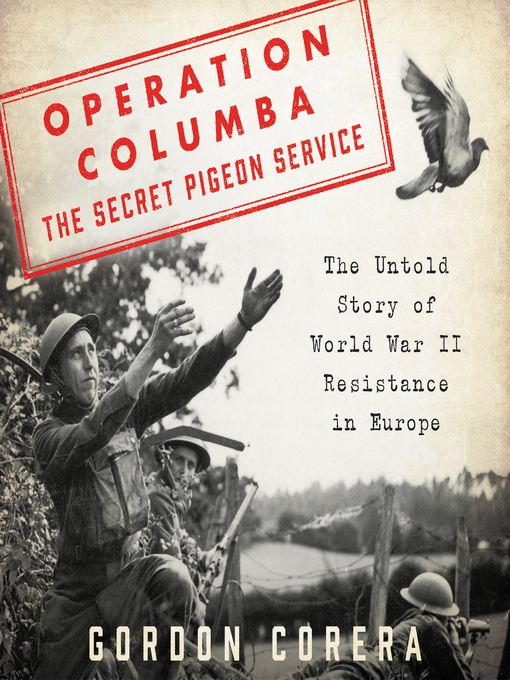
Operation Columba—The Secret Pigeon Service
The Untold Story of World War II Resistance in Europe
کتاب های مرتبط
- اطلاعات
- نقد و بررسی
- دیدگاه کاربران
نقد و بررسی

August 20, 2018
Corera (Intercept: The Secret History of Surveillance, Hacking and Digital Espionage), a security correspondent for BBC News, unearths the intriguing story of the homing pigeon service used by British intelligence during WWII to communicate with the Resistance in occupied Europe. MI14 dropped more than 16,000 pigeons “in an arc” from Copenhagen to Bordeaux. The messages the pigeons brought back, written on sheets of rice paper and folded into canisters clipped on their legs by ordinary men and women living under German occupation, provided valuable information on everything from German morale to troop movements. Witty and meticulously researched, Corera’s narrative highlights the story of a small Belgian resistance cell led by Catholic priest Joseph Raskin, who provided Operation Columba with such superior intelligence that two agents were parachuted in to help him, contributing to dire consequences for the whole group. He vividly describes the rivalries and lack of coordination among British intelligence branches, the memorable “array of oddballs and professors” who made up MI14, the network of resistance members and trained agents in the occupied territories, and the German spies who penetrated their cells. Corera succeeds in bringing a virtually unknown chapter of the war to life and pays tribute to the ordinary people who risked their lives to resist the Nazis.

October 1, 2018
BBC News correspondent Corera (Cyberspies) crafts a remarkable tale about an aspect of World War II espionage that is probably little known to most readers. Since the days of the Romans, armies have used an old technology to gather information about the enemy: homing pigeons, or Columba livia. Between April 1941 and September 1944, British forces dropped more than 16,000 of these highly trained birds across the entire western coast of Europe. Thousands did not survive; they were either eaten or turned over to the occupying German army. But thousands more did return to England with tiny messages enclosed in metal bands around their legs. Brave individuals living under the extreme stress of German control sent information with the birds about German troop movements, armament installations, and a host of other details, small and large, about the German military situation in occupied Europe. VERDICT A well-researched, fascinating account of spying during World War II.--Ed Goedeken, Iowa State Univ. Lib., Ames
Copyright 2018 Library Journal, LLC Used with permission.

August 15, 2018
The war in Europe takes to the skies--on the wings of birds.Courier pigeons are the stuff of World War I set pieces, but they were still useful two decades later. As BBC security correspondent Corera (Cyberspies: The Secret History of Surveillance, Hacking, and Digital Espionage, 2016, etc.) writes, "in 2011, Chinese state media announced that a special unit of the People's Liberation Army was training pigeons to conduct 'special military missions.'" In this lively story, the author focuses closely on a British operation called Operation Columba, which seeded mostly rural areas of occupied Western Europe with more than 16,000 homing pigeons. Some of the birds returned to British hands with accounts of life under Nazi rule, while others brought more substantial news of gun positions, troop movements, and the like. One principal was a chaplain to Belgium's King Leopold, organizing a cell of pigeon fanciers dubbed Leopold Vindictive that caused the Nazis fits. Corera is a touch too generous with the details of just how the birds did their work; one page he devotes to a pigeon's transit could be distilled to a couple of sentences. Still, there's undeniable drama in these pages, not just for the birds, the targets for German snipers' rifles and hungry hawks alike, but also for the groups of Resistance fighters who took part in Columba and, through the diligence of Belgian collaborators and Nazi officials (among them was a lawyer who "had been instrumental in taking National Socialist ideology and expressing it in the form of laws and decrees"), sometimes paid with their lives. Among the highlights of the narrative are Winston Churchill's personal intervention in the program and the author's good-natured, sometimes-wry approach to the material: "If the Nazis came through your door," he writes, "you might be able to explain away a pigeon but not a radio transmitter." Throughout, he offers reminders of how dangerous the enterprise was and how difficult the odds were: Of those 16,000 birds, only 10 percent survived.A capable, readable look at a little-known corner of history.
COPYRIGHT(2018) Kirkus Reviews, ALL RIGHTS RESERVED.

























دیدگاه کاربران